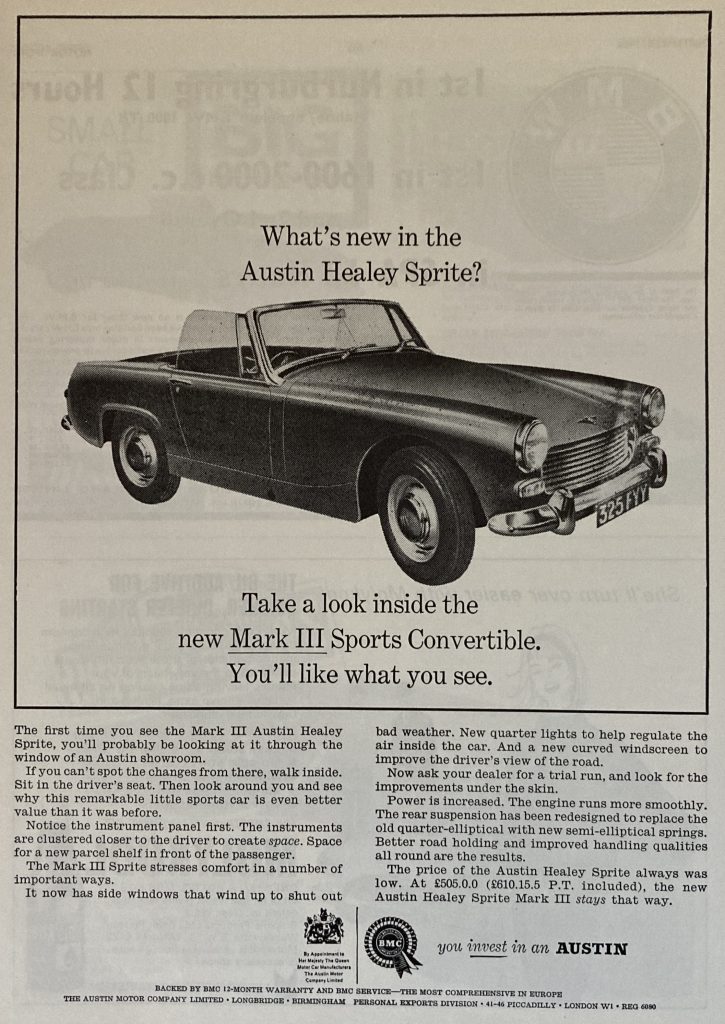There were probably two golden ages for the affordable drop-top. The most recent was kick-started at the end of the 1980s by Mazda and its MX-5, which brought on a wave of imitators that eventually petered out in the mid-2000s or so. The only survivor today is the MX-5 itself.
The first lasted all the way from the postwar period until probably the late 1970s. While that era is celebrated for cars from the likes of Lotus, Alfa Romeo, and Fiat, most of the credit must surely go to MG and Austin-Healey, whose Midget and Sprite were about the most affordable of the lot, and came to virtually define the segment from the late 1950s to the late 1970s.

The MG turned out to be the big seller, but it was an Austin-Healey at heart, the famous Frogeye that was offered until the Midget was introduced in 1961, when the car lost its grinning visage and took on a boxier form. Think of it as the 1960s equivalent of the Fiat Multipla getting its more restrained 2004 facelift, with a similar split between those who felt the car lost some character, and others who could finally look it in the eyes without either laughing or crying.
Either way, the new look persisted until the Sprite disappeared in 1971 and in MG form until Abingdon brought in the rubber bumpers in 1974. Some people probably prefer the look of these ones too, though we suspect they’re in a minority, just as they are with the similarly plastic-capped MGBs.
Somewhere between froggy faces and polypropylene, there was the Mk III Sprite pictured above. The Mk III arrived in 1964, just as the first baby boomers were reaching driving age and could set about enjoying – and defining – the Swinging Sixties. You’ll recall that 1964 was when the Beatles truly took off as international superstars, the year that Top of the Pops first aired, when Paddy Hopkirk won the Monte in a Mini, and the year of the first proper Bond blockbuster, Goldfinger.

BMC and later British Leyland had a reputation for resting on their laurels and failing to develop their cars to their true potential, but Austin-Healey and MG actually made a bit of an effort with the Mk III Sprite to justify its place in this cultural melting pot.
The first thing you’d probably notice is that you enter via regular exterior door handles. Next, you’d spot that all the instruments were grouped in their own panel, rather than across a single dashboard piece, liberating a passenger-side parcel shelf, and meaning driver and passenger had a place to put things besides their pockets.
Next, you’d probably spot the winding side windows (with quarterlights for ventilation), finally replacing the separate plexiglass units that had persisted up until then. The windscreen was now curved, too, albeit gently, rather than being a flat panel.
The A-Series’ capacity remained at 1098cc, but it was revised with a stronger block and thicker main bearings, something that helped with smoother running and a touch more power, while underneath, BMC binned quarter-elliptical leaf springs for semi-elliptical ones, to the benefit of both ride quality and axle location.
Perhaps most importantly, though, the Sprite was still very affordable. At launch in 1958, the car had come in at £668, including £223 in purchase tax. Six years later, it was actually cheaper: just over £610, including £105 in purchase tax, a figure that equates to a scarcely believable £10,400 today.
The world has made plenty of progress over the last 70 years, but the affordability (and indeed, availability) of fun little roadsters has undoubtedly taken an enormous step backwards.







